Home MacProf DTP and Web Design ,,,,,
Vellum 2 (as we write this review at 2.1.4) represents the evolution of a project started a few years ago, aimed at drastically simplifying the flow of creating an ePub document, automating many of the techniques for managing the stills, the conversion and above all the compilation of the final file for the different platforms (including Amazon).
We have already talked about Vellum, both in the review of version 1.x and in the presentation of the news of version 2.0: especially here at Cyber Layman Vellum 2 we use it a lot because it is with this that we create some of our books (for example “The Mac according to me” and “Smartwatch 2.0“).
The choice of Vellum 2 was no coincidence, despite even more powerful software circulating, adopting such a simple and beautiful App for creation leaves more space for writing, which is always the most important.
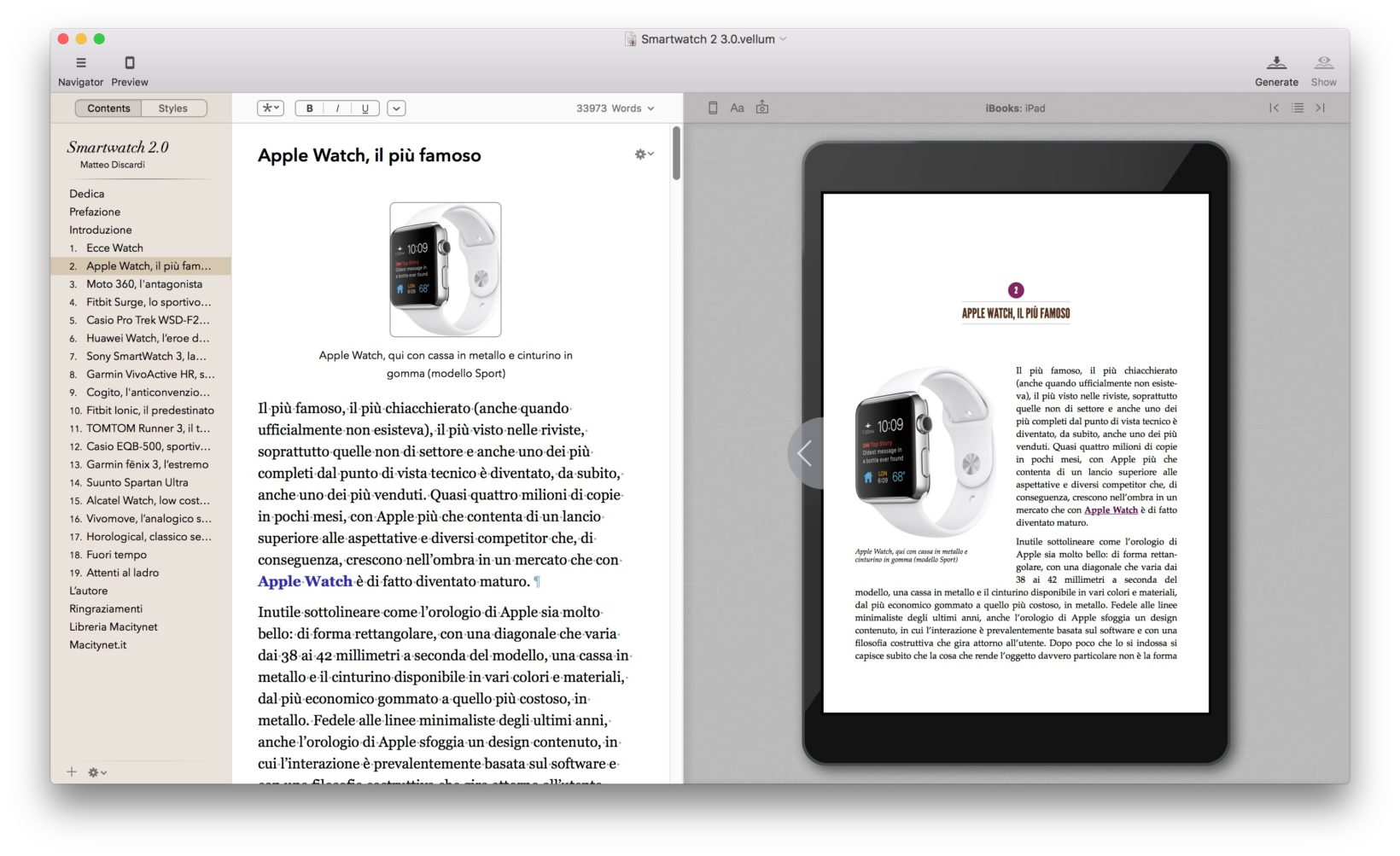 The interface of Vellum, with the editor on the left and the preview, which is updated in real time, on the right, on the device you prefer
The interface of Vellum, with the editor on the left and the preview, which is updated in real time, on the right, on the device you prefer
The soul of an ePub
If it is true that an ePub was created to be a digital book with above all text and some images (with captions), it is also true that the rules of the various online stores (Kobo, iBook Store, Amazon, Nook ) propose optimization systems that are difficult to take for granted and an error can affect the results of a product (it happens for example with Amazon, which values the weight in MB of each book).
Vellum 2 was born with the idea of proposing a friendly environment for the writer, and making it autonomous in all phases of creating a document: from writing to the correct insertion of the images, from the choice of style (which will be adopted, in whole or in part to depending on the store) up to the export stage, complete with optimization according to the different platforms.
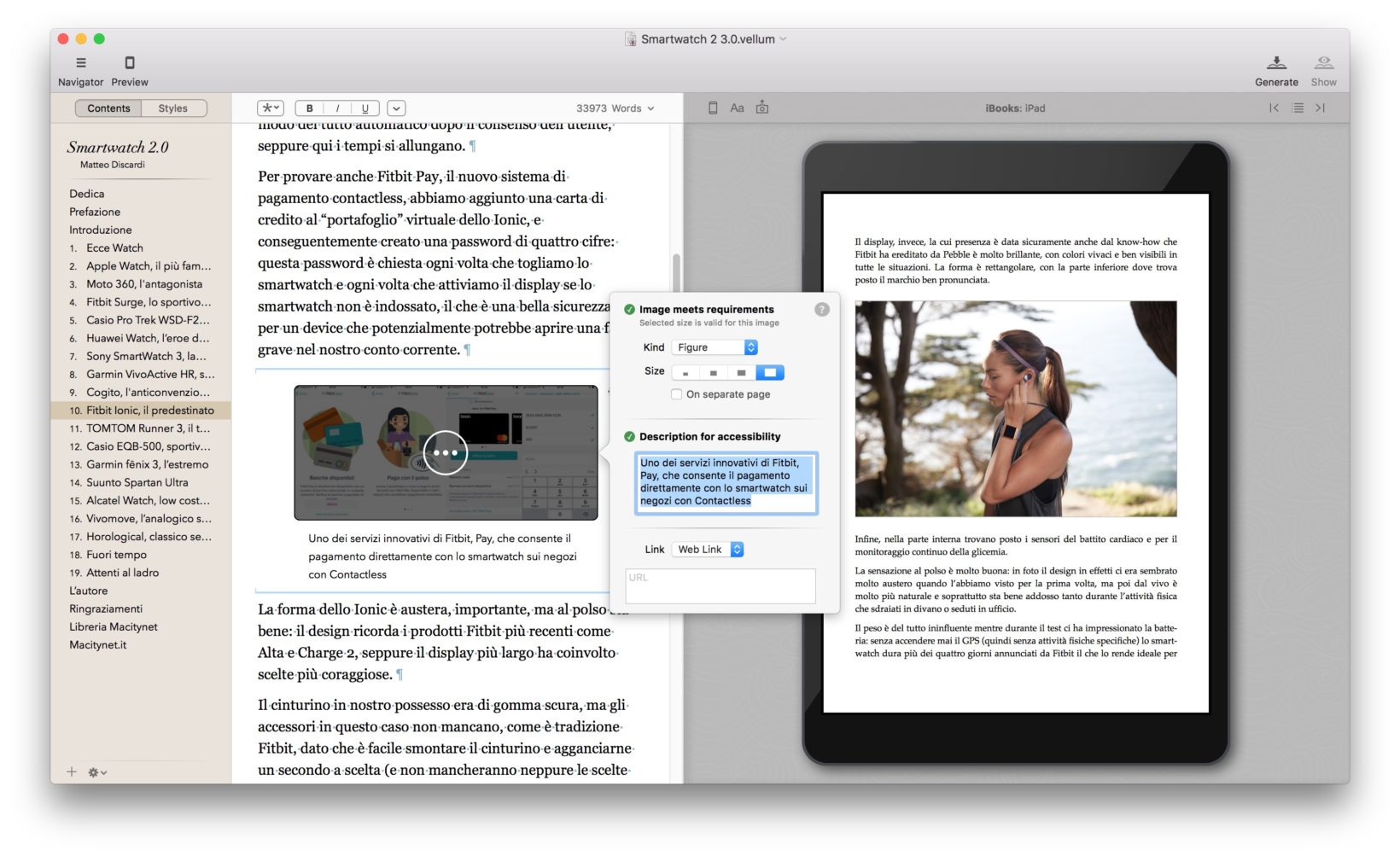 A detail on the treatment nto of the images
A detail on the treatment nto of the images
Vellum 2 is not Word, mind you, because it does not have even a tenth of the potential of the famous writing software in terms of flexibility in the writing phase, but it is much more flexible than Microsoft app in the management of a file dedicated to an ePub and in the end, for this task, it is better.
The software allows you to write and edit the text, fill in all the metadata cards, automating the process of creating the index and publishing, for which you must necessarily use the tools of the various shops.
At the end of the process comes what is the first novelty of version 2 compared to the first incarnation : if then Vellum could be used linked to some single licenses, for example you could use Vellum 2 for a single book (and then export it as many times as you wanted, limited to the same title) in this second version the developers have returned to a more classic vend ita license, divided into simple license (only ePub / kindle) or with Paperback (also in PDF).
The price is questionable: it costs like an Office license, but the internal procedures are judged of the writer are worth the sum, because it saves a lot of headaches.
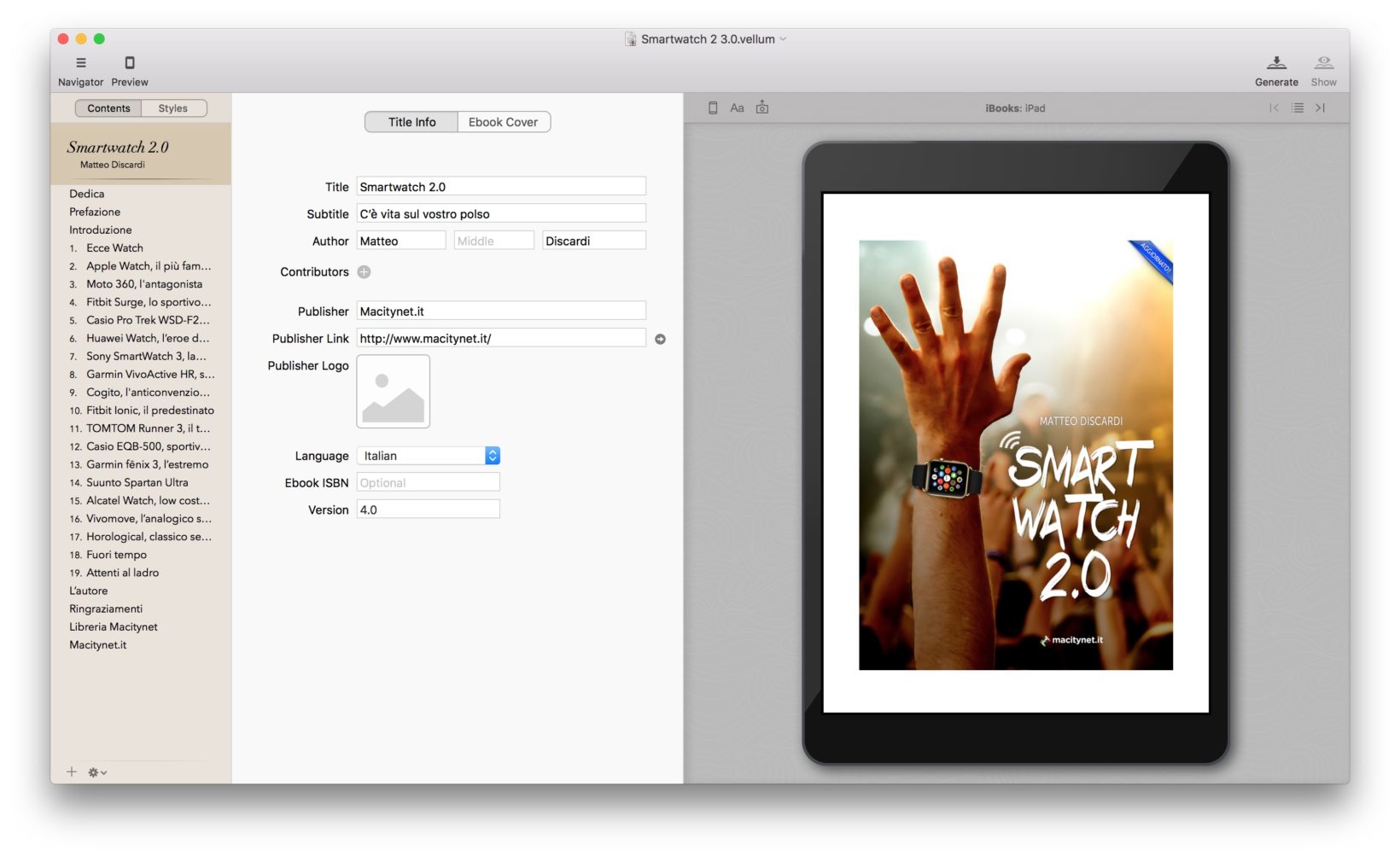 The Vellum metadata editor where just insert the cover and fill in the fields
The Vellum metadata editor where just insert the cover and fill in the fields
Vellum 2.0, the future is vintage
The most important novelty of Vellum 2 is undoubtedly the possibility, for those who buy the Paperback version (about 50 dollars more expensive than the basic version) to create not only an electronic book, but also a PDF that becomes useful in case of printing, for all those commercial realities that in addition to electronic publishing also want to make a more concrete copy (excluding the cover, which must be paginated separately, for obvious reasons).
For printing, the App takes its cue from the same styles of the electronic edition, inheriting in everything and for t all the aspect, the images and, if desired, also the index of the chapters (which in the ePub is dynamically generated).
 The export phase
The export phase
Obviously forget the artifices and convolutions of QuarkXPress or Adobe InDesign, in this case Vellum 2 is designed for the layout of very classic textbooks, so the only option you need to worry about is the space in the fold and whether the book will be in color or black and white.
If you need a more complex layout, with images and customizations in the layout, Vellum 2 is not the right App : it is instead if the book is very classic, scholastic or fictional, a guide or a manual, a novel or a collection of poems.
The part relating to the press is treated like a digital output, for which it goes to the export queue, from which we can decide some characteristics: more than anything else because the App lacks the classic Print command, so the PDF output is the only v ia to obtain a paper copy, useful for example also for a correction (for those who cannot read on the screen).
The implementation of exporting an RTF file is also interesting, convenient for example to be managed by a more advanced software for tasks other than those for which Vellum 2 was designed.
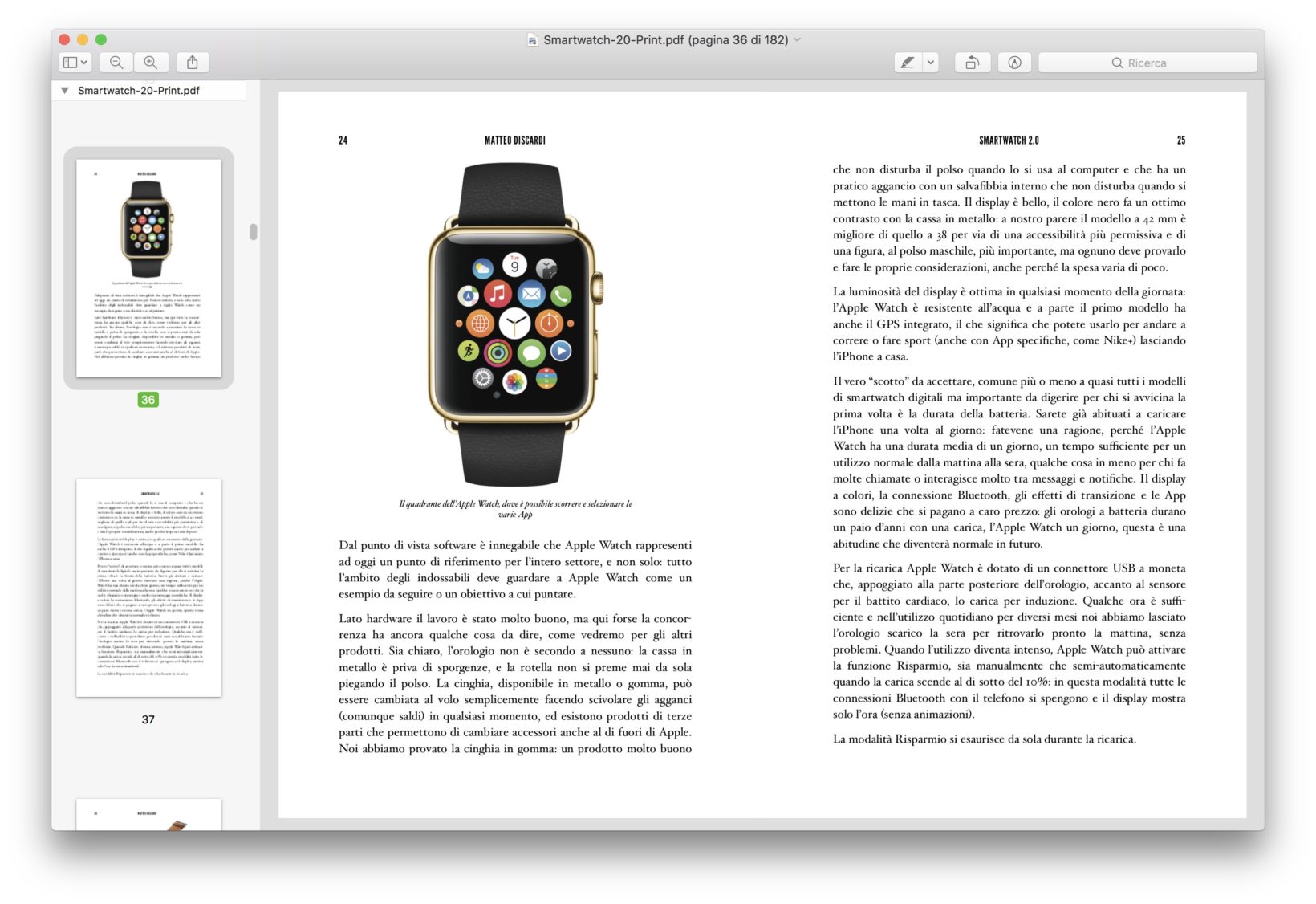 The novelty of Vellum 2.0, l 'export in PDF format (for printing)
The novelty of Vellum 2.0, l 'export in PDF format (for printing)
A good basis
Our opinion is that the starting point of Vellum was already excellent, with cutting-edge features for an ePub editor: a (very) easy but intelligent environment with modern and delightful automation systems, such as the ability to import a Word document (in .docx format) and divide it already into chapters, as well as the ability to manage chapters, sub-chapters and volumes dynamically, as if they were Lego bricks. And with this, in itself, it is very different from the most classic layouts, that this elasticity and immediacy have never had it.
To this is added the extreme optimization of the document in all the features, including those related to the images that are adapted according to the specifications of the store (factor not to be underestimated) and to the standard elements of the file, such as the name of the parts and the localization (which is performed here automatically).
Finally, the styles that are in a nutshell, delicious: initially proposed as eight different layouts, they can be customized in every single part by mixing the characteristics in a very personal way.
In the face of this, we would have liked a more advanced style editor, so as to be able to create a completely personal style also in the form, not only in the intersections, but perhaps this is a much more complex possibility than it seems, because every modification in this sense it goes to clash with the needs of different shops, which impose rules that developers know much better than us.
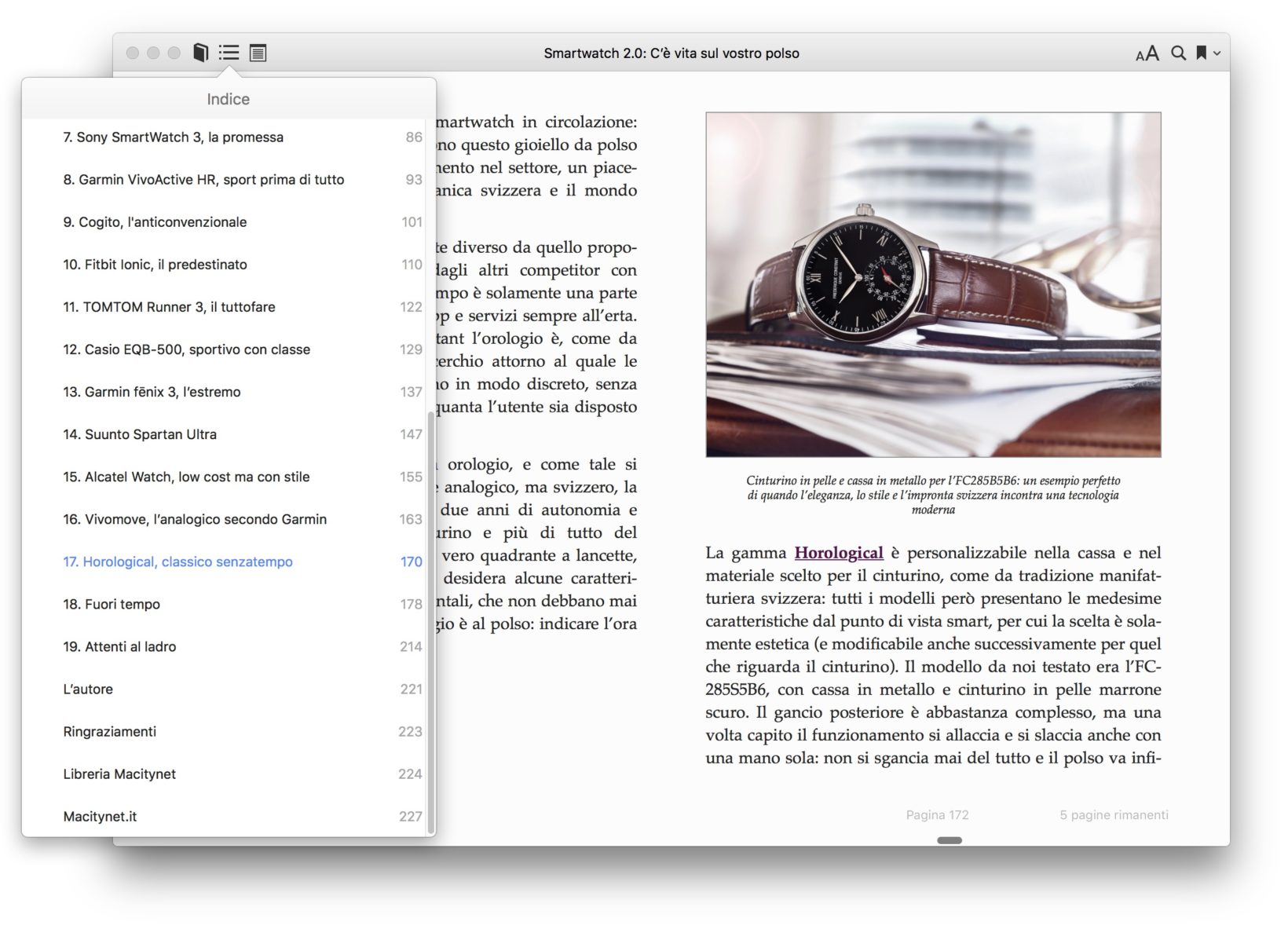 Our ePub, seen here on iBooks of macOS 10.13
Our ePub, seen here on iBooks of macOS 10.13
Conclusions
Vellum 2.0 is the ideal App if you are looking for a fast, easy, powerful editor designed for writing, adapt and create an ePub / Kindle totally independently, whether you are a private individual with a passion for writing or a small publishing house that wants to break into the world of electronic publishing.
The things that Vellum 2 it does, it does her a lot, but very well; the things it does not do are useless from the point of view for which it is designed: the Paperback version is suitable for those who also want to print the books it publishes, but we recommend it anyway, because a copy in PDF is always needed, from editing to copying security.
The price is important, but in our opinion perfectly justified, because the use of Vellum 2 especially during the writing phase allows you to reduce times that would be very long and save precious hours on the final phase, otherwise so difficult as to require external help.
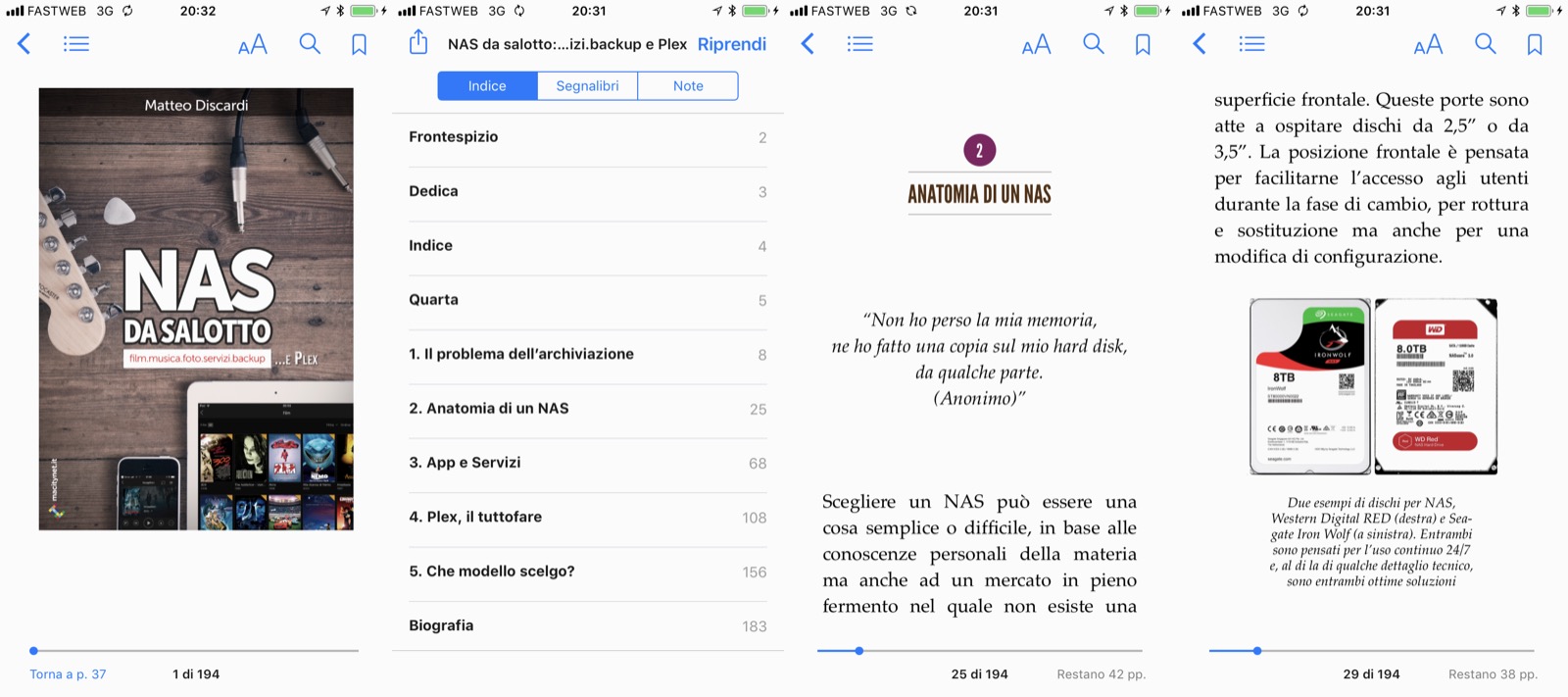 An ePub created with Vellum 2, here on iPhone
An ePub created with Vellum 2, here on iPhone
We would like to recommend Vellum for all those who are thinking of writing and self-publishing texts on Amazon, iBook Store, Kobo and other online stores: Vellum 2 autormatic systems in this perspective are perfect, powerful and optimized to perfection. , but above all within everyone's reach, leaving only the task to the user, far from it easy, of writing. If you have a Mac and want to publish an ePub there are few solutions, and this is one of the best for us.
Readers can start using Vellum right away by downloading it from the manufacturer's website, by writing and creating the first ePub, playing with preferences, styles and seeing the preview in real time, and then proceeding with the purchase at the time of the actual publication.
Pro :
Against :
Price: $ 199.99 ($ 249.99 for the Paperback edition)
,,





